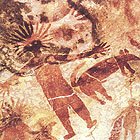Dogs are often referred to as ‘man’s best friend’, but the relationship between man and dog may be much more important than we realise. Research just completed suggests that dogs and humans co-evolved – we’ve certainly changed them to suit us, but they may have changed us too. It’s possible that dogs actually helped form the modern human being.
Nature Australia article
In our segment Don spoke with Dr. Paul Taçon, Principal Research Scientist at the Australian Museum. He is co-author (with Dr. Colin Pardoe) of an article in Nature Australia magazine titled ‘Dogs Make Us Human’, which examines the many ways we have been influenced by dogs.
Paul explained that it’s only in the last decade or so that the history of dogs and humans worldwide has been critically examined. While the archaeological evidence suggests that dogs have been widespread for about 14,000 years, recent genetic and fossil evidence suggests they may have been around for over 100,000 years. Some researchers are arguing that dogs may have been with us throughout the whole critical period of our development, and that the dog actually helped turn us into modern humans both anatomically and behaviourally.
Man meets dog
The amazing relationship between man and dog probably began when wolves hung around early human camps scavenging for food scraps. They may have tagged along when the humans went on hunting trips, and helped to sniff out and chase down prey. They would also have guarded the camp, and warned of the approach of predators and enemies. The early humans may have reared puppies and started to breed them selectively, eventually leading to the emergence of the dog all over the world in the many forms we know today.
Goodbye Neanderthals
Cohabitation with dogs would have improved the chances of survival for early humans, and given them a competitive advantage. There is no evidence that Neanderthals had dogs, which could explain why Neanderthals became extinct and not us. Taçon and his colleagues argue that living with dogs has had profound effects on human psychology, hunting practices, territoriality and social behaviour. They say that soon after wolves/dogs began to live with humans, we learnt to hunt big game in packs. This is a distinctive wolf behavioural trait and there is no evidence of it among pre-sapiens groups. It’s also possible that humans learnt a bit about the nature of territory by watching wolves mark their territory with urine. The archaeological record shows that humans began to mark their territories with hand prints and stencils, grooves in rock and finger impressions in clay. Engraved and painted pictures became common about 40,000 years ago. These are different to the simple markings earlier humans made.
The relationship continues
The modern dog is still our best friend. There are guide dogs for the blind, hearing dogs for the deaf and therapy dogs for the infirm. In fact, many studies have shown how elderly and disabled people survive much better with a dog as a companion. The long, close relationship man has had with the dog continues today. Dogs and humans still interact, and possibly still transform and change each other.
Further reading
‘Dogs Make Us Human’ by Paul S.C. Taçon and Colin Pardoe. Nature Australia Magazine, Autumn 2002.



